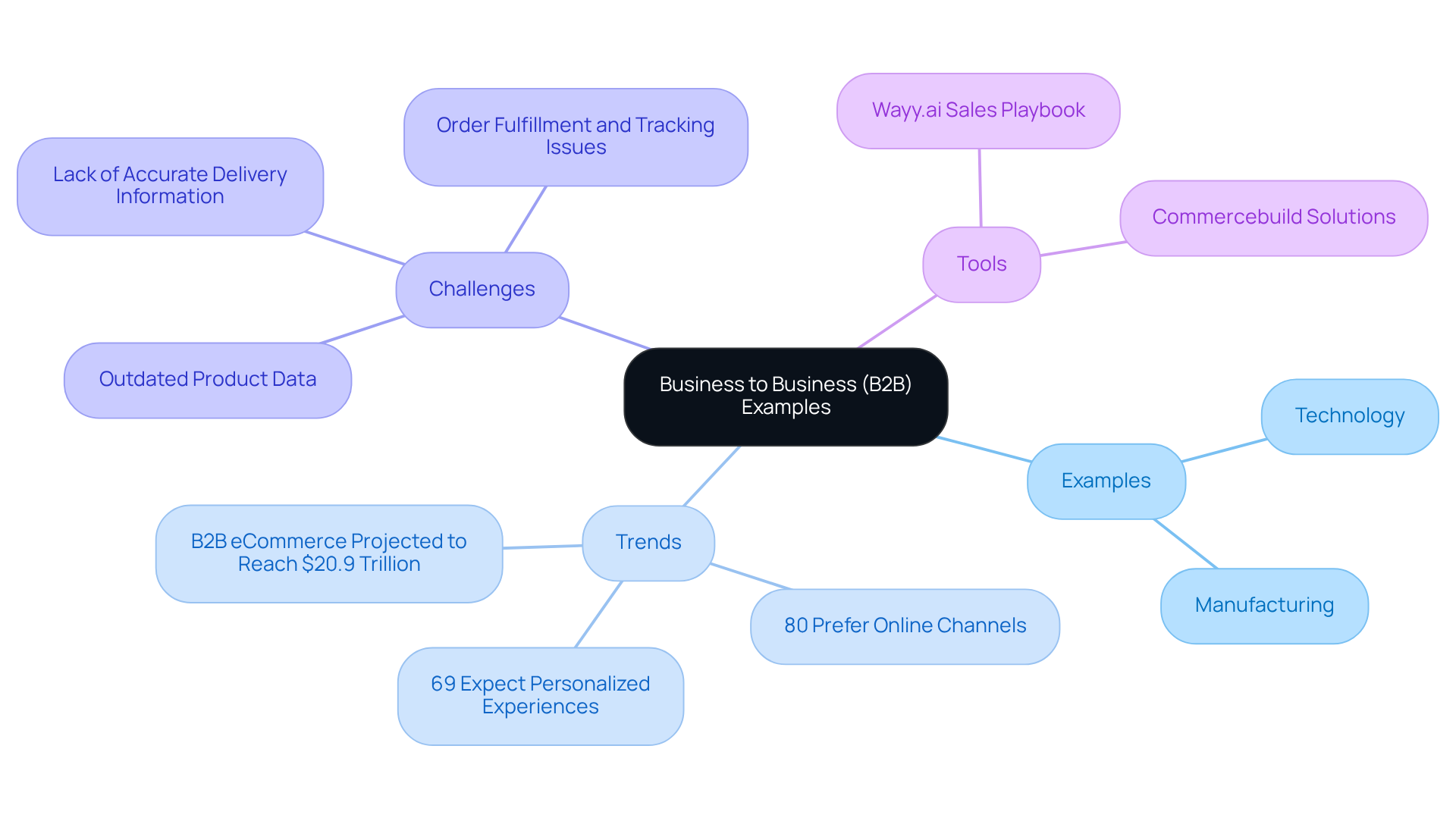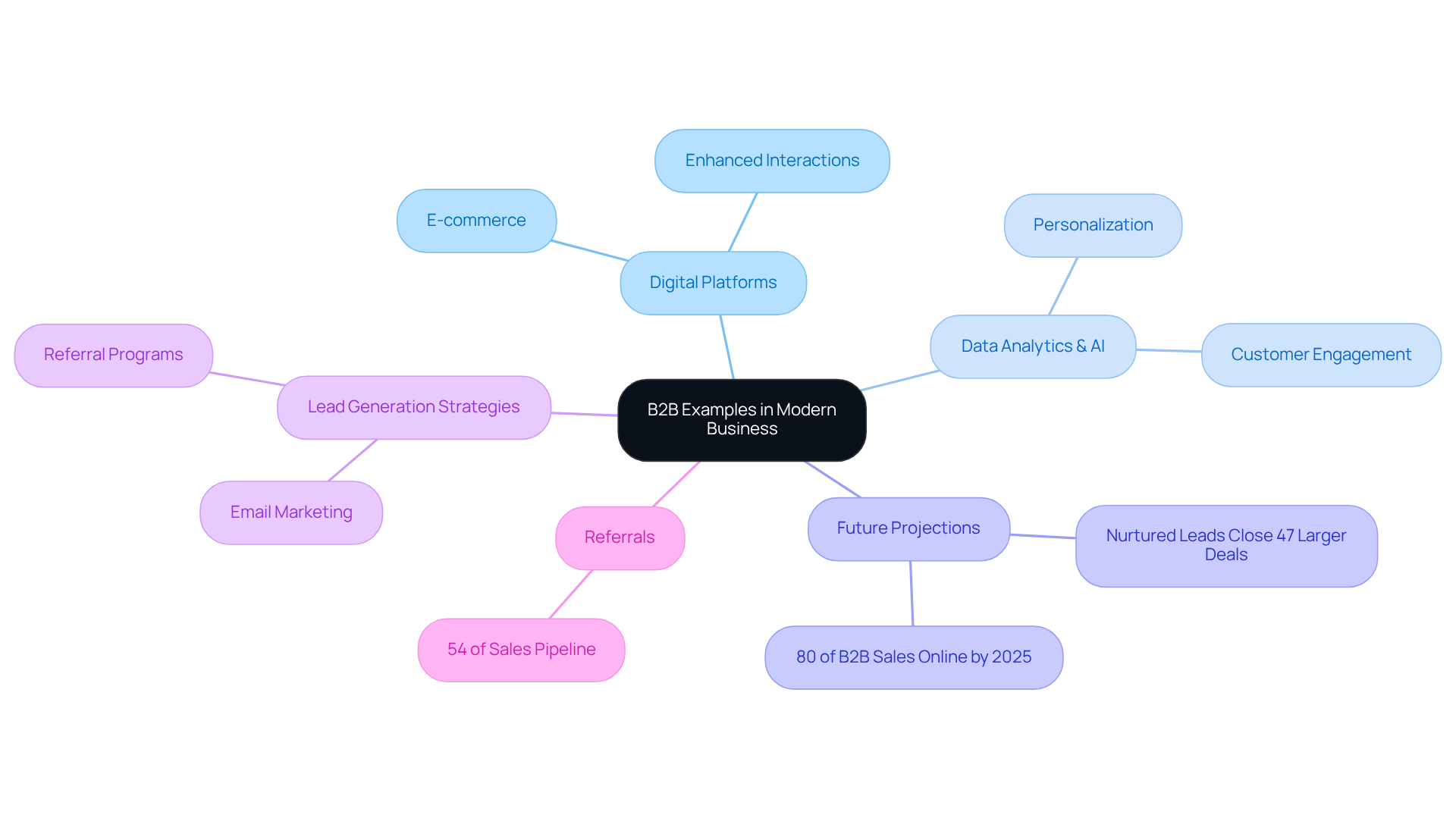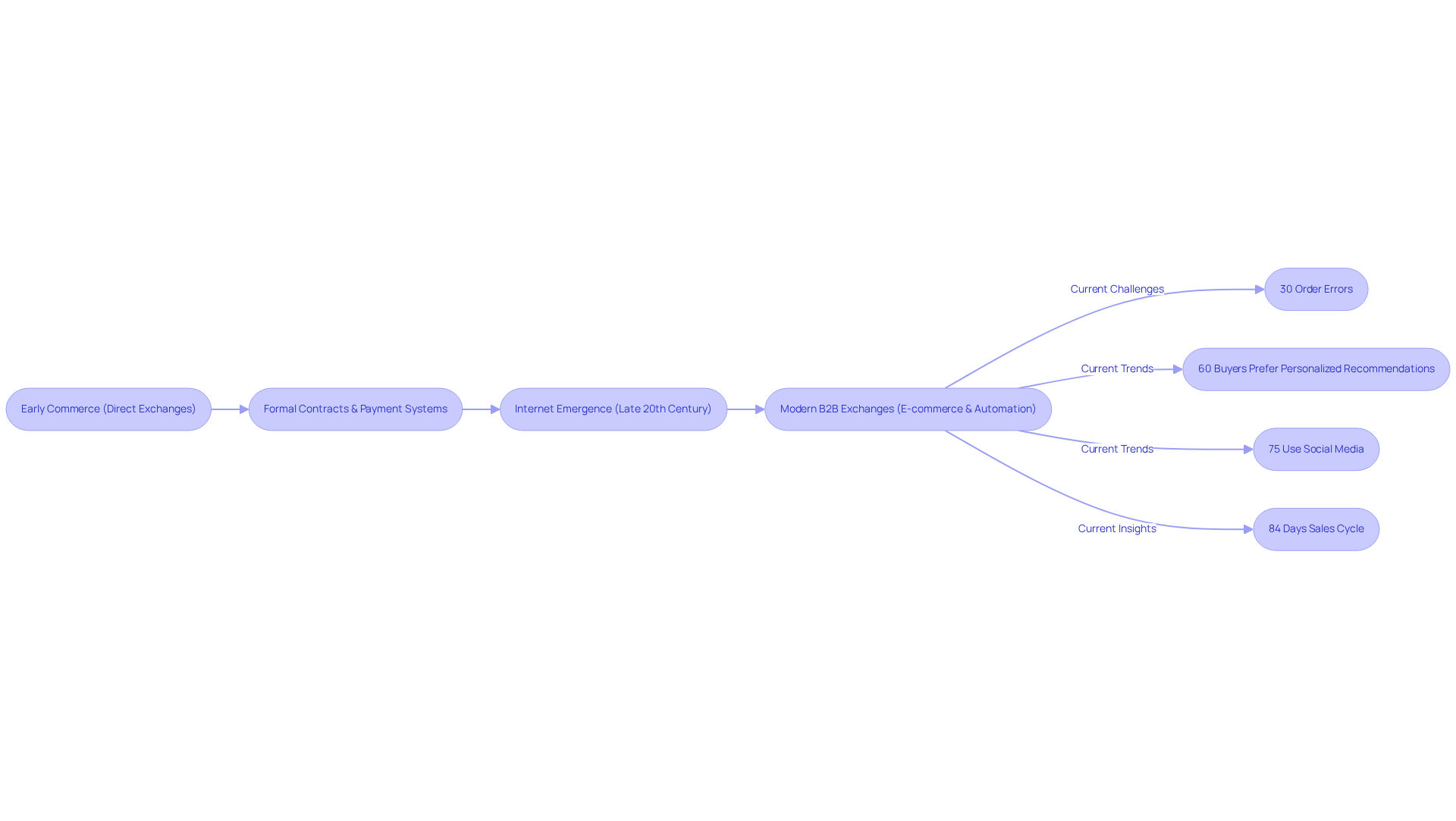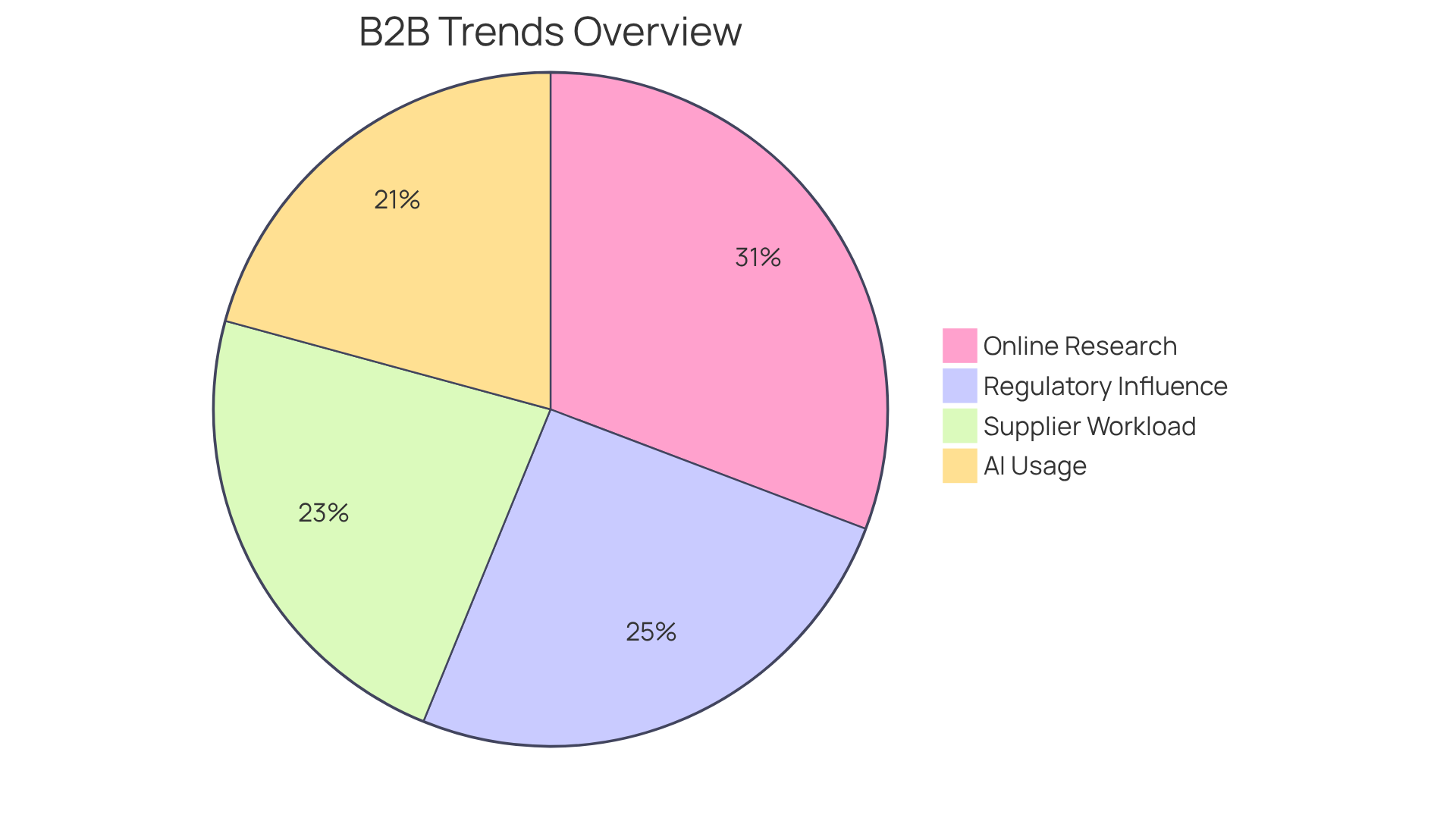Overview
This article delves into various business-to-business (B2B) examples and their profound influence on modern commerce, particularly highlighting the transition towards digital platforms and personalized interactions.
We understand that navigating this landscape can be challenging, and we want to shed light on how technology can be a powerful ally in making transactions more efficient.
Did you know that 80% of B2B buyers prefer online channels? This statistic underscores the importance of adapting to these preferences.
Furthermore, personalized outreach can lead to larger deals, which is a testament to the evolving dynamics of B2B relationships.
Together, we can explore these changes and empower your business to thrive in this digital age.
Introduction
As companies increasingly pivot towards digital solutions, we understand that the landscape of Business to Business (B2B) transactions is evolving at an unprecedented pace. These interactions, often characterized by complexity and volume, are not just essential for operational efficiency; they are becoming critical to meeting the personalized demands of modern buyers. Yet, with this transformation comes a pressing question: how can we effectively navigate the challenges of this digital shift? By leveraging B2B examples, we can foster growth and strengthen relationships together.
It's important to recognize that you're not alone in this journey. Many businesses face similar hurdles as they adapt to new technologies and changing buyer expectations. Reflecting on these challenges can help us identify effective strategies that resonate with your unique experiences. Together, we can explore solutions that not only address these issues but also empower you to thrive in this evolving landscape.
Define Business to Business (B2B) Examples
Business to Business (B2B) exchanges are vital interactions between companies, setting them apart from Business to Consumer (B2C) engagements. For instance, manufacturers often sell products to wholesalers, and software firms provide services to other businesses. These transactions typically involve larger volumes and often necessitate complex negotiations and agreements, which can feel daunting.
Currently, there’s a significant shift towards digital platforms, with 80% of B2B buyers preferring online channels for their purchases. This digital transformation is not just a trend; it’s a response to the growing demand for personalized experiences. In fact, 69% of B2B buyers expect shopping interactions tailored to their needs, much like those offered by leading eCommerce platforms. Are you feeling the pressure to meet these expectations?
Successful business to business examples span various sectors, including technology, where companies utilize cloud services to boost operational efficiency, and manufacturing, where suppliers enhance logistics through integrated systems. Notably, 17% of all eCommerce activities now stem from B2B purchases, highlighting the increasing recognition of these interactions' importance in the broader market landscape.
As more companies engage in B2B exchanges, the focus on personalization, speed, and transparency becomes essential. Companies that embrace these expectations are better positioned to thrive in the competitive B2B environment, ultimately driving growth and boosting customer satisfaction. To ease the burden of client acquisition, tools like Wayy.ai's one-click sales playbook can significantly enhance the efficiency of your B2B sales strategies. This tool empowers small business owners to conduct product research, identify key value propositions, and build targeted customer profiles, helping you create outreach plans that truly resonate with your audience.
However, challenges remain. Many businesses face hurdles such as inaccurate information about delivery times and the operational headaches of order fulfillment and tracking. Addressing these issues is crucial for sustained success. Together, we can and achieve your business goals.

Contextualize B2B Examples in Modern Business
In today's commercial landscape, we understand that business to business examples of transactions are becoming increasingly essential, driven by globalization and rapid technological advancements. Companies like yours are harnessing digital platforms to enhance interactions, which serve as business to business examples, leading to more efficient and accessible processes. For instance, e-commerce platforms are prime business to business examples that create valuable connections between businesses and suppliers worldwide, simplifying procurement and sales processes.
Moreover, the integration of data analytics and AI tools allows for a more personalized approach in business to business examples of marketing strategies. This personalization significantly improves customer engagement and drives sales, which is vital for your growth. As you navigate these transformations, grasping the dynamics of business to business examples is crucial for achieving sustainable success.
Looking ahead, it is projected that by 2025, 80% of B2B sales interactions will occur through digital channels. This underscores the importance of adapting to a digital-first approach. Additionally, consider this: nurtured leads in B2B environments close deals that are 47% larger than those from cold prospects. This highlights the effectiveness of personalized outreach strategies.
Furthermore, referrals contribute to 54% of the sales pipeline, emphasizing the need for effective lead generation strategies. As the landscape continues to evolve, prioritizing technology adoption will be essential for remaining competitive and meeting the sophisticated demands of modern buyers. Together, we can and achieve success in this dynamic environment.

Trace the Evolution of B2B Transactions
The evolution of [B2B exchanges](https://wayy.ai) can be traced back to the early days of commerce, where trade was conducted through direct exchanges of goods and services. As economies expanded, the need for more organized exchanges emerged, leading to the creation of formal contracts and payment systems. With the advent of the internet in the late 20th century, there emerged numerous of interactions that underwent a remarkable transformation, enabling companies to conduct business activities online. Today, B2B exchanges are characterized by advanced e-commerce platforms, automated payment systems, and data-driven marketing strategies. This shift reflects a significant move towards digitalization and efficiency in operations, which we understand is crucial for your success.
However, navigating this landscape is not without its challenges. For instance:
- Order errors impact over 30% of transactions, leading to frustrations that many of you may experience due to absent stock information.
- We know how important personalized recommendations are; after all, 60% of B2B buyers prefer to engage with companies that offer tailored suggestions.
- Additionally, social media plays a pivotal role in your outreach efforts, with 75% of market leaders leveraging platforms like LinkedIn for commercial solutions.
Moreover, [the typical duration of the B2B sales cycle is 84 days](https://coalitiontechnologies.com/blog/b2b-ecommerce-stats-2025), underscoring the time commitment necessary for these exchanges. These statistics highlight the essential role of the internet in shaping contemporary business to business examples, which enable quicker, more effective, and tailored interactions among companies. Together, we can navigate these challenges and harness the opportunities that lie ahead.

Identify Key Characteristics of Effective B2B Examples
Successful business to business examples highlight key characteristics that significantly enhance their effectiveness. At the heart of this success is strong relationship management, where businesses prioritize nurturing long-term partnerships with clients and suppliers. This approach is vital, as 91% of purchasers are more inclined to engage with organizations that offer relevant, personalized interactions. Clear communication and transparency are equally important, ensuring that everyone involved understands expectations and deliverables. In fact, 44% of purchasers will overlook a sales call if the salesperson hasn't taken the time to research their organization, highlighting the need for informed conversations.
Moreover, focusing on value generation is essential. Organizations must tailor their offerings to meet the specific needs of their customers. This customization not only boosts customer satisfaction but also fosters loyalty, as evidenced by a remarkable 47% increase in customer retention reported by companies utilizing CRM systems. For instance, Mack’s Truck Sales achieved £1 million in revenue within just two months of implementing Lead Forensics, demonstrating the power of leveraging technology for lead generation.
Finally, embracing technology for automation and data analysis can enhance operational efficiency and decision-making. Businesses that use CRM can see a staggering 300% increase in lead conversion rates, enabling them to respond quickly to market changes and customer demands. With , small business owners can gain valuable daily email insights tracking key metrics like how many leads were reached, who expressed interest, and how conversion rates are improving. These insights directly inform business to business examples, enabling businesses to adjust their strategies based on real-time data. This data-driven approach, coupled with the growing trend of 70% of B2B firms incorporating AI into their sales strategies, underscores the importance of integrating these technologies. By implementing these strategies, we can enhance B2B communication efficiency and overall success together.

Examine Real-World Applications of B2B Examples
In today's world, the significance of business to business examples resonates across various sectors, and we recognize the challenges you face in navigating this landscape. Take the technology industry, for example, where business to business examples such as Salesforce showcase how customer relationship management (CRM) solutions can truly streamline sales processes and enhance customer engagement. Did you know that 54% of B2B marketers are utilizing AI for site search? This statistic highlights the growing importance of technology in improving B2B interactions, something that can directly impact your business.
In manufacturing, many businesses establish long-term contracts with B2B suppliers for raw materials, which serve as business to business examples, ensuring consistent quality and pricing. This approach is becoming increasingly crucial, especially as 66% of procurement professionals anticipate that regulatory and ESG demands will significantly influence sourcing strategies in the coming years. It’s essential to stay ahead of these trends to secure your supply chain.
Moreover, the rise of business to business examples like Alibaba has transformed product sourcing. These platforms enable companies to connect with suppliers worldwide and negotiate favorable terms, making it easier for you to find what you need. It's noteworthy that 80% of B2B buyers conduct their research online before making purchasing decisions. This emphasizes the importance of digital channels in modern B2B transactions, which you can leverage to your advantage.
Additionally, 60% of suppliers acknowledge that key customers expect them to manage excessive administrative work. This reality underscores the challenges faced in B2B relationships, and it’s vital to find ways to streamline these processes. Together, we can . These business to business examples collectively illustrate the critical role of B2B interactions in driving business success and adapting to evolving market demands. Let's work towards a future where your business can thrive in this dynamic environment.

Conclusion
Understanding the nuances of Business to Business (B2B) interactions is crucial in today’s interconnected economy. These exchanges, distinct from Business to Consumer (B2C) transactions, play a pivotal role in driving growth and enhancing operational efficiencies. As businesses increasingly shift towards digital platforms, recognizing the significance of B2B examples becomes essential for navigating the complexities of modern commerce.
This article highlights several key aspects of B2B transactions, including:
- The growing preference for online purchasing
- The importance of personalization in buyer interactions
- The challenges businesses face, such as order fulfillment and communication gaps
It emphasizes that successful B2B relationships are built on strong management practices, clear communication, and the effective use of technology, all of which together foster loyalty and satisfaction among clients.
As the landscape continues to evolve, it is imperative for businesses to adapt and embrace these changes. The projected growth of digital sales interactions underscores the necessity of prioritizing technology and personalized strategies. By leveraging insights and tools available, businesses can streamline their operations and position themselves for sustained success in a competitive environment. Engaging with these B2B dynamics will ultimately empower organizations to thrive and meet the sophisticated demands of their clientele.
Together, we can navigate these challenges and seize opportunities that arise in this dynamic marketplace. Let’s prioritize the connections that matter and work towards a future where every interaction is meaningful and beneficial for all parties involved.
Frequently Asked Questions
What is Business to Business (B2B) and how does it differ from Business to Consumer (B2C)?
Business to Business (B2B) refers to transactions and exchanges between companies, such as manufacturers selling to wholesalers or software firms providing services to other businesses. This differs from Business to Consumer (B2C), which involves transactions between businesses and individual consumers.
What are some examples of B2B transactions?
Examples of B2B transactions include manufacturers supplying products to wholesalers, software companies offering services to other businesses, and e-commerce platforms facilitating connections between businesses and suppliers.
What trends are shaping the B2B landscape today?
There is a significant shift towards digital platforms, with 80% of B2B buyers preferring online channels. Personalization is also becoming crucial, as 69% of B2B buyers expect tailored shopping experiences similar to those in B2C eCommerce.
How important is personalization in B2B interactions?
Personalization is essential in B2B interactions, as it enhances customer engagement and drives sales. Companies that focus on personalized experiences are better positioned to thrive and meet the demands of modern buyers.
What role does technology play in B2B transactions?
Technology, including data analytics and AI tools, plays a vital role in improving marketing strategies and customer engagement in B2B transactions. It helps businesses create targeted outreach plans and streamline procurement and sales processes.
What are some challenges businesses face in B2B transactions?
Common challenges include inaccurate information about delivery times, operational issues related to order fulfillment, and tracking. Addressing these challenges is crucial for sustained success in the B2B environment.
What is the projected future of B2B sales interactions?
It is projected that by 2025, 80% of B2B sales interactions will occur through digital channels, highlighting the need for businesses to adopt a digital-first approach to remain competitive.
How do referrals impact B2B sales?
Referrals account for 54% of the sales pipeline in B2B environments, emphasizing the importance of effective lead generation strategies and nurturing leads to close larger deals.
What tools can assist in improving B2B sales strategies?
Tools like Wayy.ai's one-click sales playbook can enhance B2B sales strategies by helping small business owners conduct product research, identify key value propositions, and build targeted customer profiles for effective outreach.




